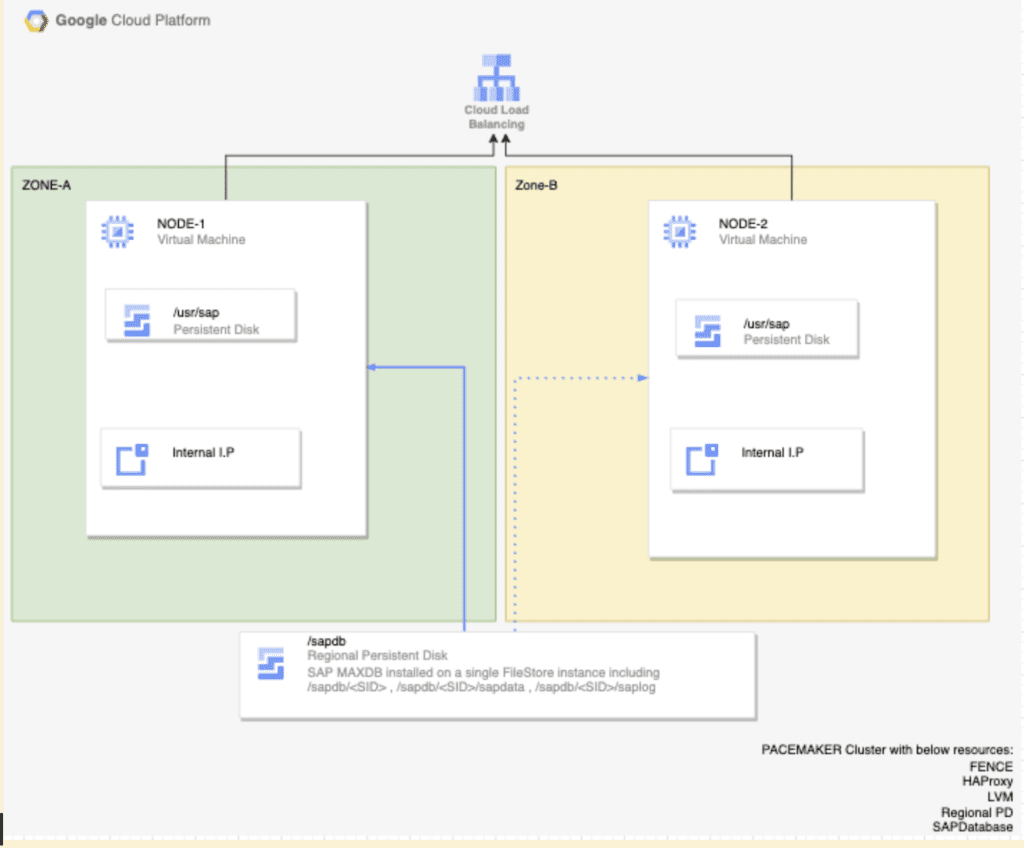The SAP introduction
With typical use cases like: SAP’s MaxDB database is a crucial component of a customer’s setup.
- SAP Content Server is used to store documents.
- Advanced Planner and Optimizer (APO) or Supply Chain Management (SCM) services using SAP LiveCache
- In certain circumstances, the SAP Business All-In-One client’s main database
The capacity to make strategic, tactical, and operational choices will also be significantly impacted by downtime for these systems.
The Google Cloud Consulting team has developed a solution to offer high availability (HA) for SAP’s MaxDB database using Google Cloud’s Regional Persistent Disk (referred to as RPD in this article). This solution uses Google Cloud’s inherent storage capabilities.
This solution assisted in securing the environment for a crucial internal application that served over 120K users in production at a recent client account.
Options for MaxDB High Availability Were Considered
Let’s take a look at some of the more conventional MaxDB high availability alternatives available before moving on to Regional PD.

As said, the aforementioned options have certain drawbacks. For instance, recovery durations for the Standby Database depend on how many Redo logs need to be performed and need user involvement. Although the Hot Standby offers a quicker recovery time, it is dependent on a third party vendor for an API library that functions as part of the SAP MaxDB runtime environment. The creation of a data model is necessary to build master & client table definitions since the Synchronization Manager is unable to manage large change rate volumes. To make sure cluster settings are configured properly, the storage-based cluster has to be tuned.
Localized PD Solution
A regional persistent disk is what, exactly?
A storage choice called regional PD offers synchronous data replication between two zones within a region.
The advantage of regional persistent disks is that you may forcibly connect a regional persistent disk to a VM instance in a secondary zone in the same region in the case of a zonal outage, which might cause your virtual machine (VM) instance to become unavailable.
Comparing Regional PD with Other Storage Options
Regional PD is not the only option for storing shared files, of course. There are options for managed file store solutions as well as manually setting up an NFS-based server (or pair for HA). Here is an overview of how such options compare to Regional PD.

Architecture
Two nodes are spread across two zones in the design, and an internal load balancer uses the HAProxy health check listener to direct traffic to the active Primary database instance.
On a single Regional PD, the database binaries, data area, and log area for the MaxDB database instance are all installed.

Linux distributions employ Pacemaker, a high availability cluster resource management. The following list represents the collection of Pacemaker resource agents needed for configuration:
- For the health check listener procedure, HAProxy
- Detach and reattach the regional PD with the command GCP-PD-MOVE
- After moving the disk to the other node, use LVM to activate or deactivate the logical volume.
- To mount/unmount the /sapdb filesystem, use the filesystem command.
- To oversee and manage the MaxDB database, use SAPDatabase.
- GCP Fencing agent Fence_GCE
Conclusion
Find out whether the Regional PD solution is appropriate for your situation if your SAP MaxDB-based application demands high availability. Here are a few things to think about:
- Check to see if it matches your criteria and choose a GCP approved machine type for SAP as Regional PD is supported for certain machine kinds. View the complete list of supported machine types for Regional PD.
- Due of the fact that you can only expand upwards, start modest with Regional PD size restrictions.
- Verify that your block storage’s IOPS and Throughput needs match what Regional PD provides.

[…] enrich and contextualize each event with the most recent, industry-leading threat intelligence from Google Cloud, Mandiant, and […]
[…] States, which is a really exciting development for us to share with you. As part of this release, SAP National Security Services (SAP NS2), a supplier of secure cloud services for government and […]
[…] The Cloud Storage Acceleration Layer (CSAL) team from Intel was bought by Solidigm earlier this year. The team at Intel had been working on Optane as a companion drive for slower media and had open-sourced their work in the Storage Performance Development Kit. […]
[…] a leading provider of analytics, data-enabled solutions, and worldwide property information, on Google Cloud. It recently deployed a number of Google Cloud technologies, which increased operational efficiency […]
[…] of the quickest ways to lift and convert your current VMware estate into Google Cloud is with the Google Cloud VMware Engine. With special features like a 4 nines uptime SLA in a single […]